The Impact of Welfare State Regimes on Social Problems and Wellbeing
VerifiedAdded on 2023/01/12
|8
|2115
|2
Essay
AI Summary
This essay delves into the concept of welfare state regimes, examining their influence on social policy, gender dynamics, and employment structures. It explores three primary perspectives: liberal, conservative, and social democratic welfare regimes, highlighting their distinct approaches to addressing social problems such as inequality, poverty, and unemployment. The essay analyzes how each regime tackles these issues through varying levels of government intervention, emphasis on family values, and access to social services. It also discusses the relationship between welfare regimes and social capital, healthcare benefits, and economic outcomes, drawing on relevant literature to assess their effectiveness in promoting social wellbeing. The analysis further explores the impact of these regimes on gender pay gaps and healthcare access, emphasizing the advantages and disadvantages associated with each approach. Ultimately, the essay underscores the significant role of welfare state regimes in shaping societal structures and influencing the overall wellbeing of citizens.
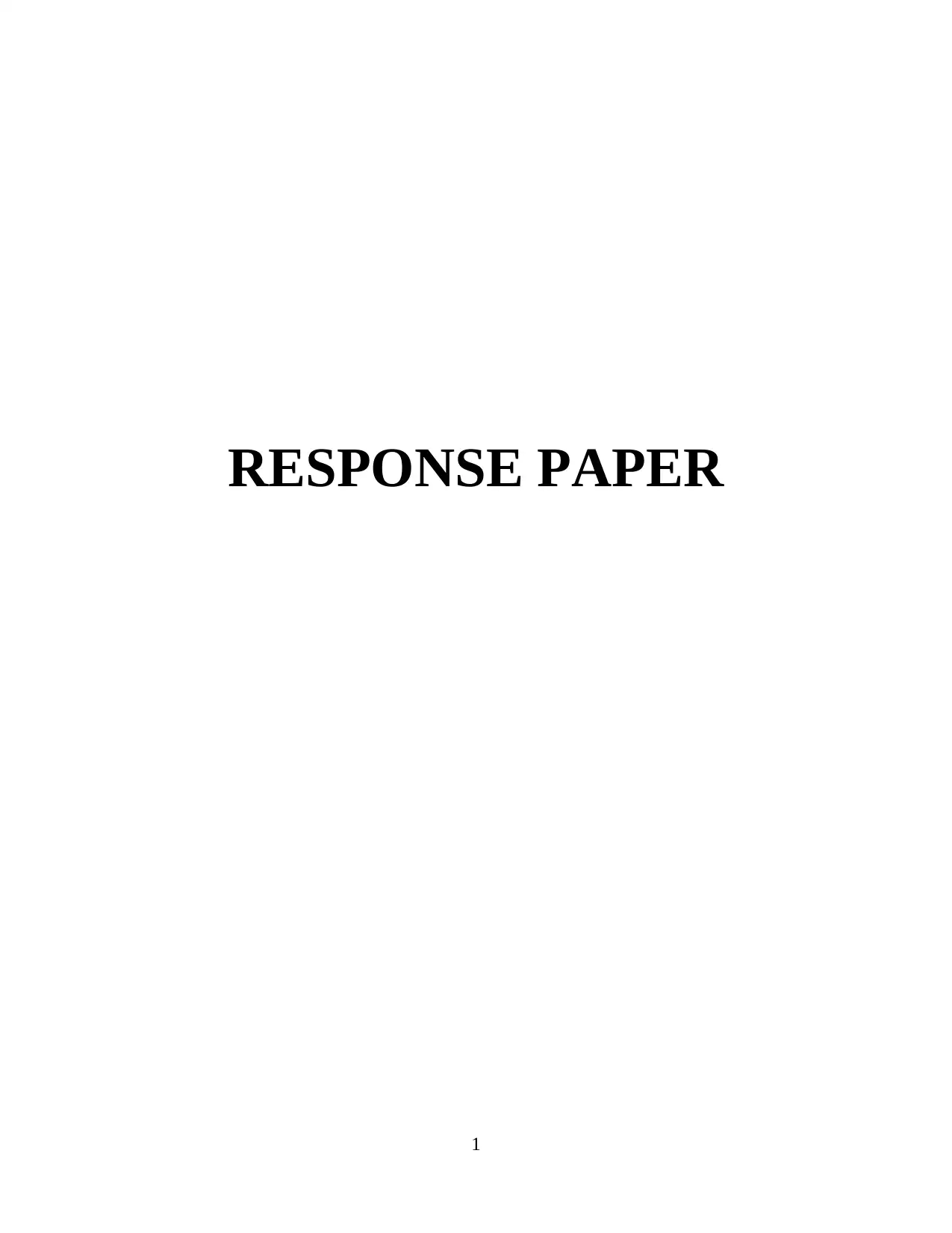
RESPONSE PAPER
1
1
Paraphrase This Document
Need a fresh take? Get an instant paraphrase of this document with our AI Paraphraser
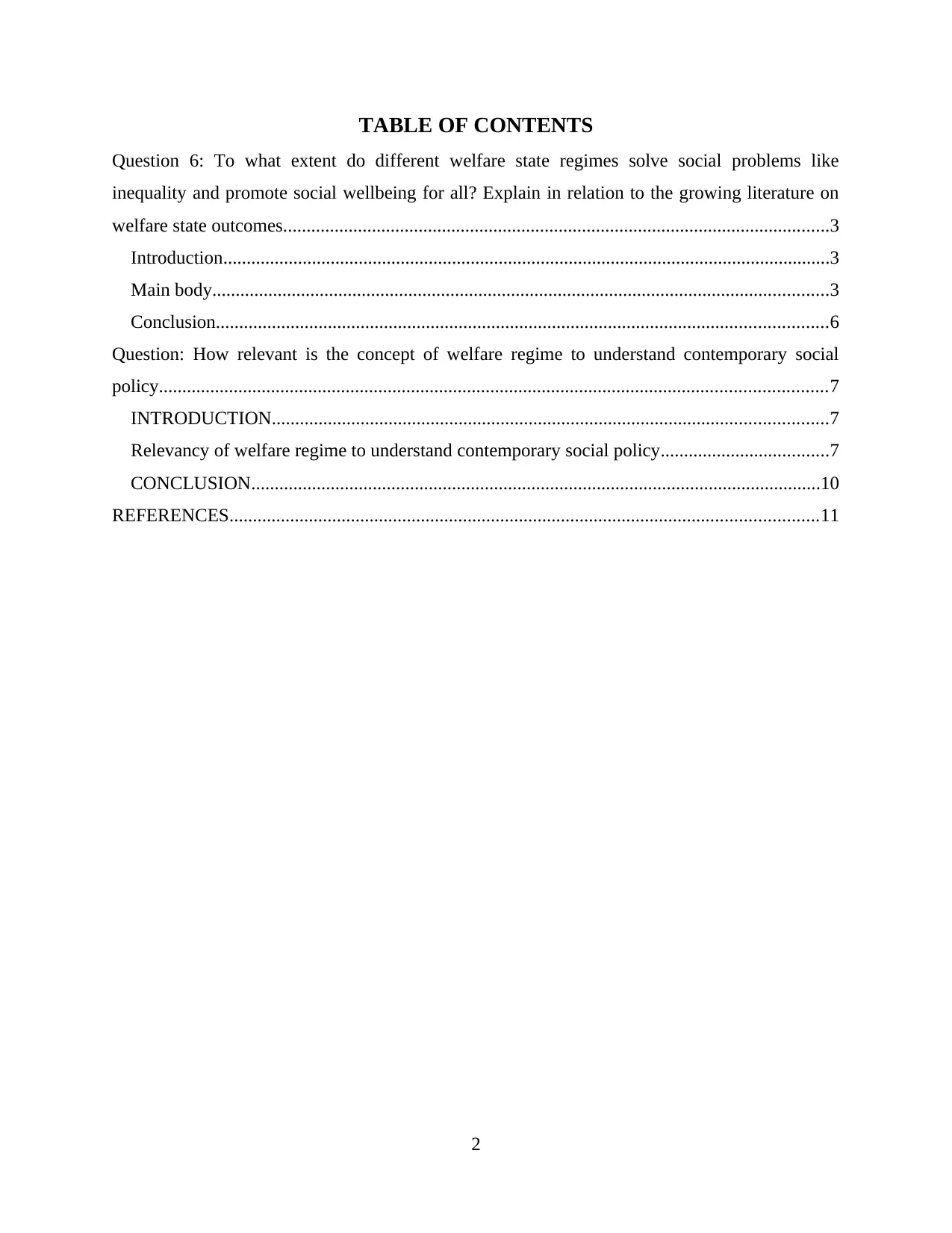
TABLE OF CONTENTS
Question 6: To what extent do different welfare state regimes solve social problems like
inequality and promote social wellbeing for all? Explain in relation to the growing literature on
welfare state outcomes.....................................................................................................................3
Introduction..................................................................................................................................3
Main body....................................................................................................................................3
Conclusion...................................................................................................................................6
Question: How relevant is the concept of welfare regime to understand contemporary social
policy...............................................................................................................................................7
INTRODUCTION.......................................................................................................................7
Relevancy of welfare regime to understand contemporary social policy....................................7
CONCLUSION..........................................................................................................................10
REFERENCES..............................................................................................................................11
2
Question 6: To what extent do different welfare state regimes solve social problems like
inequality and promote social wellbeing for all? Explain in relation to the growing literature on
welfare state outcomes.....................................................................................................................3
Introduction..................................................................................................................................3
Main body....................................................................................................................................3
Conclusion...................................................................................................................................6
Question: How relevant is the concept of welfare regime to understand contemporary social
policy...............................................................................................................................................7
INTRODUCTION.......................................................................................................................7
Relevancy of welfare regime to understand contemporary social policy....................................7
CONCLUSION..........................................................................................................................10
REFERENCES..............................................................................................................................11
2
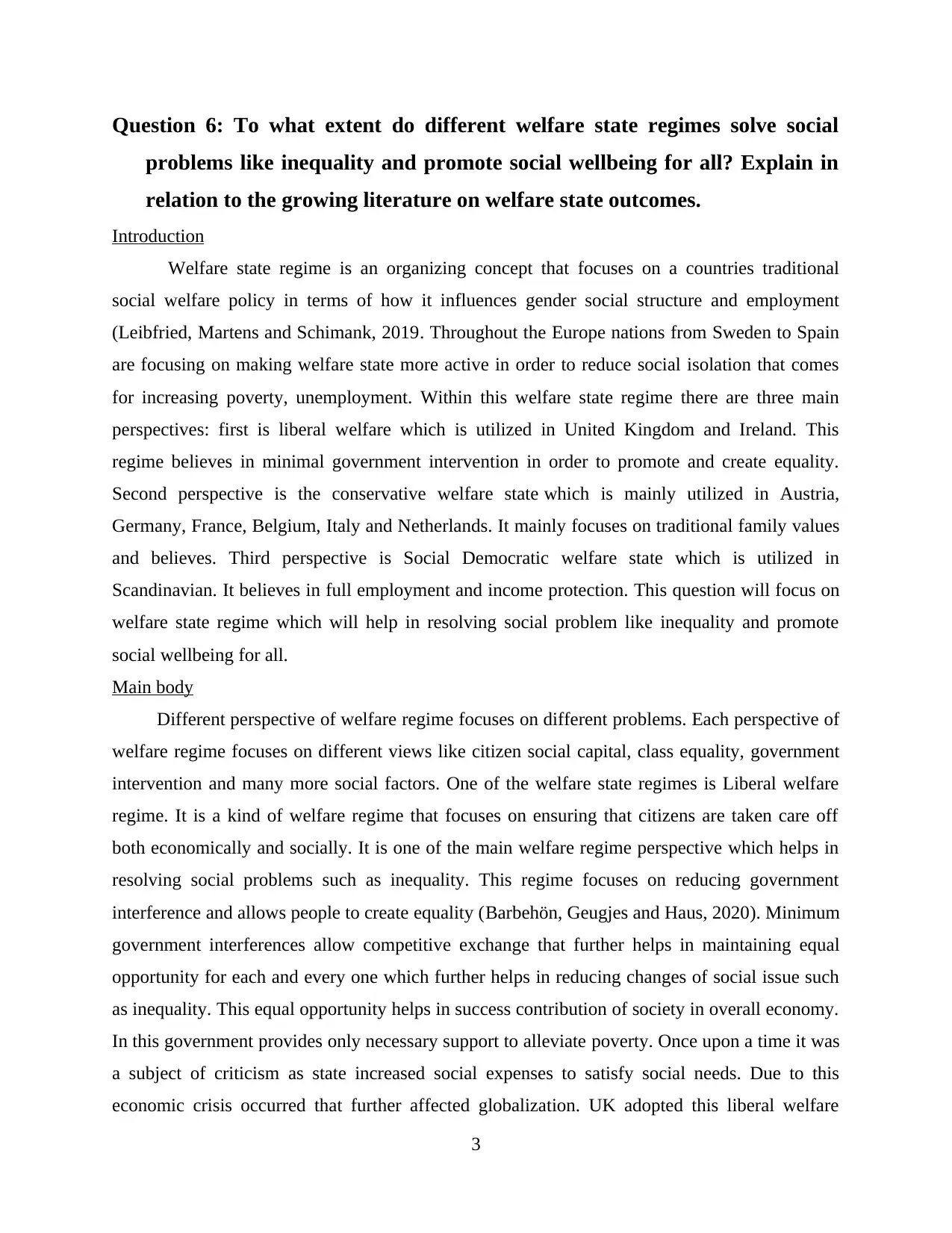
Question 6: To what extent do different welfare state regimes solve social
problems like inequality and promote social wellbeing for all? Explain in
relation to the growing literature on welfare state outcomes.
Introduction
Welfare state regime is an organizing concept that focuses on a countries traditional
social welfare policy in terms of how it influences gender social structure and employment
(Leibfried, Martens and Schimank, 2019. Throughout the Europe nations from Sweden to Spain
are focusing on making welfare state more active in order to reduce social isolation that comes
for increasing poverty, unemployment. Within this welfare state regime there are three main
perspectives: first is liberal welfare which is utilized in United Kingdom and Ireland. This
regime believes in minimal government intervention in order to promote and create equality.
Second perspective is the conservative welfare state which is mainly utilized in Austria,
Germany, France, Belgium, Italy and Netherlands. It mainly focuses on traditional family values
and believes. Third perspective is Social Democratic welfare state which is utilized in
Scandinavian. It believes in full employment and income protection. This question will focus on
welfare state regime which will help in resolving social problem like inequality and promote
social wellbeing for all.
Main body
Different perspective of welfare regime focuses on different problems. Each perspective of
welfare regime focuses on different views like citizen social capital, class equality, government
intervention and many more social factors. One of the welfare state regimes is Liberal welfare
regime. It is a kind of welfare regime that focuses on ensuring that citizens are taken care off
both economically and socially. It is one of the main welfare regime perspective which helps in
resolving social problems such as inequality. This regime focuses on reducing government
interference and allows people to create equality (Barbehön, Geugjes and Haus, 2020). Minimum
government interferences allow competitive exchange that further helps in maintaining equal
opportunity for each and every one which further helps in reducing changes of social issue such
as inequality. This equal opportunity helps in success contribution of society in overall economy.
In this government provides only necessary support to alleviate poverty. Once upon a time it was
a subject of criticism as state increased social expenses to satisfy social needs. Due to this
economic crisis occurred that further affected globalization. UK adopted this liberal welfare
3
problems like inequality and promote social wellbeing for all? Explain in
relation to the growing literature on welfare state outcomes.
Introduction
Welfare state regime is an organizing concept that focuses on a countries traditional
social welfare policy in terms of how it influences gender social structure and employment
(Leibfried, Martens and Schimank, 2019. Throughout the Europe nations from Sweden to Spain
are focusing on making welfare state more active in order to reduce social isolation that comes
for increasing poverty, unemployment. Within this welfare state regime there are three main
perspectives: first is liberal welfare which is utilized in United Kingdom and Ireland. This
regime believes in minimal government intervention in order to promote and create equality.
Second perspective is the conservative welfare state which is mainly utilized in Austria,
Germany, France, Belgium, Italy and Netherlands. It mainly focuses on traditional family values
and believes. Third perspective is Social Democratic welfare state which is utilized in
Scandinavian. It believes in full employment and income protection. This question will focus on
welfare state regime which will help in resolving social problem like inequality and promote
social wellbeing for all.
Main body
Different perspective of welfare regime focuses on different problems. Each perspective of
welfare regime focuses on different views like citizen social capital, class equality, government
intervention and many more social factors. One of the welfare state regimes is Liberal welfare
regime. It is a kind of welfare regime that focuses on ensuring that citizens are taken care off
both economically and socially. It is one of the main welfare regime perspective which helps in
resolving social problems such as inequality. This regime focuses on reducing government
interference and allows people to create equality (Barbehön, Geugjes and Haus, 2020). Minimum
government interferences allow competitive exchange that further helps in maintaining equal
opportunity for each and every one which further helps in reducing changes of social issue such
as inequality. This equal opportunity helps in success contribution of society in overall economy.
In this government provides only necessary support to alleviate poverty. Once upon a time it was
a subject of criticism as state increased social expenses to satisfy social needs. Due to this
economic crisis occurred that further affected globalization. UK adopted this liberal welfare
3
⊘ This is a preview!⊘
Do you want full access?
Subscribe today to unlock all pages.

Trusted by 1+ million students worldwide
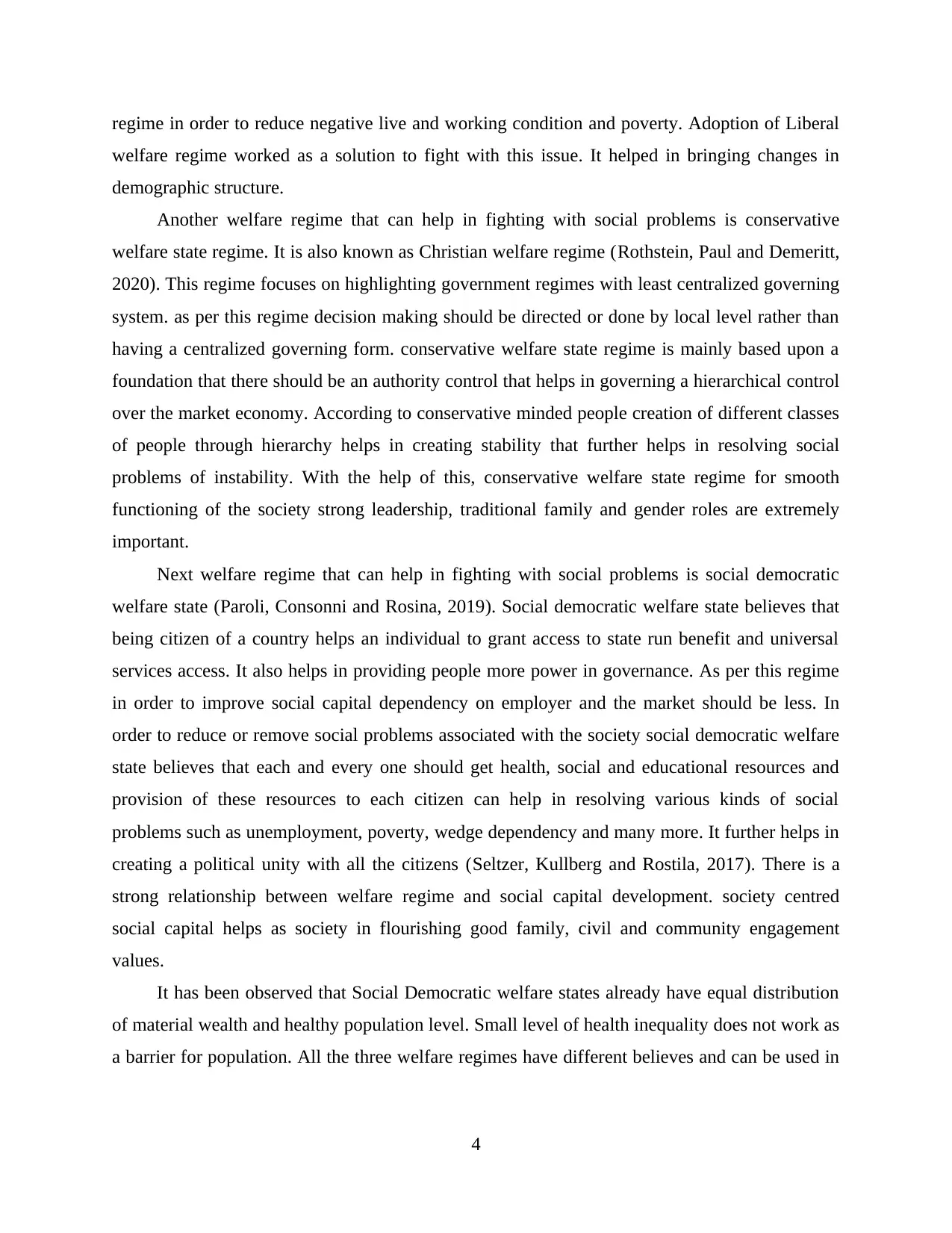
regime in order to reduce negative live and working condition and poverty. Adoption of Liberal
welfare regime worked as a solution to fight with this issue. It helped in bringing changes in
demographic structure.
Another welfare regime that can help in fighting with social problems is conservative
welfare state regime. It is also known as Christian welfare regime (Rothstein, Paul and Demeritt,
2020). This regime focuses on highlighting government regimes with least centralized governing
system. as per this regime decision making should be directed or done by local level rather than
having a centralized governing form. conservative welfare state regime is mainly based upon a
foundation that there should be an authority control that helps in governing a hierarchical control
over the market economy. According to conservative minded people creation of different classes
of people through hierarchy helps in creating stability that further helps in resolving social
problems of instability. With the help of this, conservative welfare state regime for smooth
functioning of the society strong leadership, traditional family and gender roles are extremely
important.
Next welfare regime that can help in fighting with social problems is social democratic
welfare state (Paroli, Consonni and Rosina, 2019). Social democratic welfare state believes that
being citizen of a country helps an individual to grant access to state run benefit and universal
services access. It also helps in providing people more power in governance. As per this regime
in order to improve social capital dependency on employer and the market should be less. In
order to reduce or remove social problems associated with the society social democratic welfare
state believes that each and every one should get health, social and educational resources and
provision of these resources to each citizen can help in resolving various kinds of social
problems such as unemployment, poverty, wedge dependency and many more. It further helps in
creating a political unity with all the citizens (Seltzer, Kullberg and Rostila, 2017). There is a
strong relationship between welfare regime and social capital development. society centred
social capital helps as society in flourishing good family, civil and community engagement
values.
It has been observed that Social Democratic welfare states already have equal distribution
of material wealth and healthy population level. Small level of health inequality does not work as
a barrier for population. All the three welfare regimes have different believes and can be used in
4
welfare regime worked as a solution to fight with this issue. It helped in bringing changes in
demographic structure.
Another welfare regime that can help in fighting with social problems is conservative
welfare state regime. It is also known as Christian welfare regime (Rothstein, Paul and Demeritt,
2020). This regime focuses on highlighting government regimes with least centralized governing
system. as per this regime decision making should be directed or done by local level rather than
having a centralized governing form. conservative welfare state regime is mainly based upon a
foundation that there should be an authority control that helps in governing a hierarchical control
over the market economy. According to conservative minded people creation of different classes
of people through hierarchy helps in creating stability that further helps in resolving social
problems of instability. With the help of this, conservative welfare state regime for smooth
functioning of the society strong leadership, traditional family and gender roles are extremely
important.
Next welfare regime that can help in fighting with social problems is social democratic
welfare state (Paroli, Consonni and Rosina, 2019). Social democratic welfare state believes that
being citizen of a country helps an individual to grant access to state run benefit and universal
services access. It also helps in providing people more power in governance. As per this regime
in order to improve social capital dependency on employer and the market should be less. In
order to reduce or remove social problems associated with the society social democratic welfare
state believes that each and every one should get health, social and educational resources and
provision of these resources to each citizen can help in resolving various kinds of social
problems such as unemployment, poverty, wedge dependency and many more. It further helps in
creating a political unity with all the citizens (Seltzer, Kullberg and Rostila, 2017). There is a
strong relationship between welfare regime and social capital development. society centred
social capital helps as society in flourishing good family, civil and community engagement
values.
It has been observed that Social Democratic welfare states already have equal distribution
of material wealth and healthy population level. Small level of health inequality does not work as
a barrier for population. All the three welfare regimes have different believes and can be used in
4
Paraphrase This Document
Need a fresh take? Get an instant paraphrase of this document with our AI Paraphraser
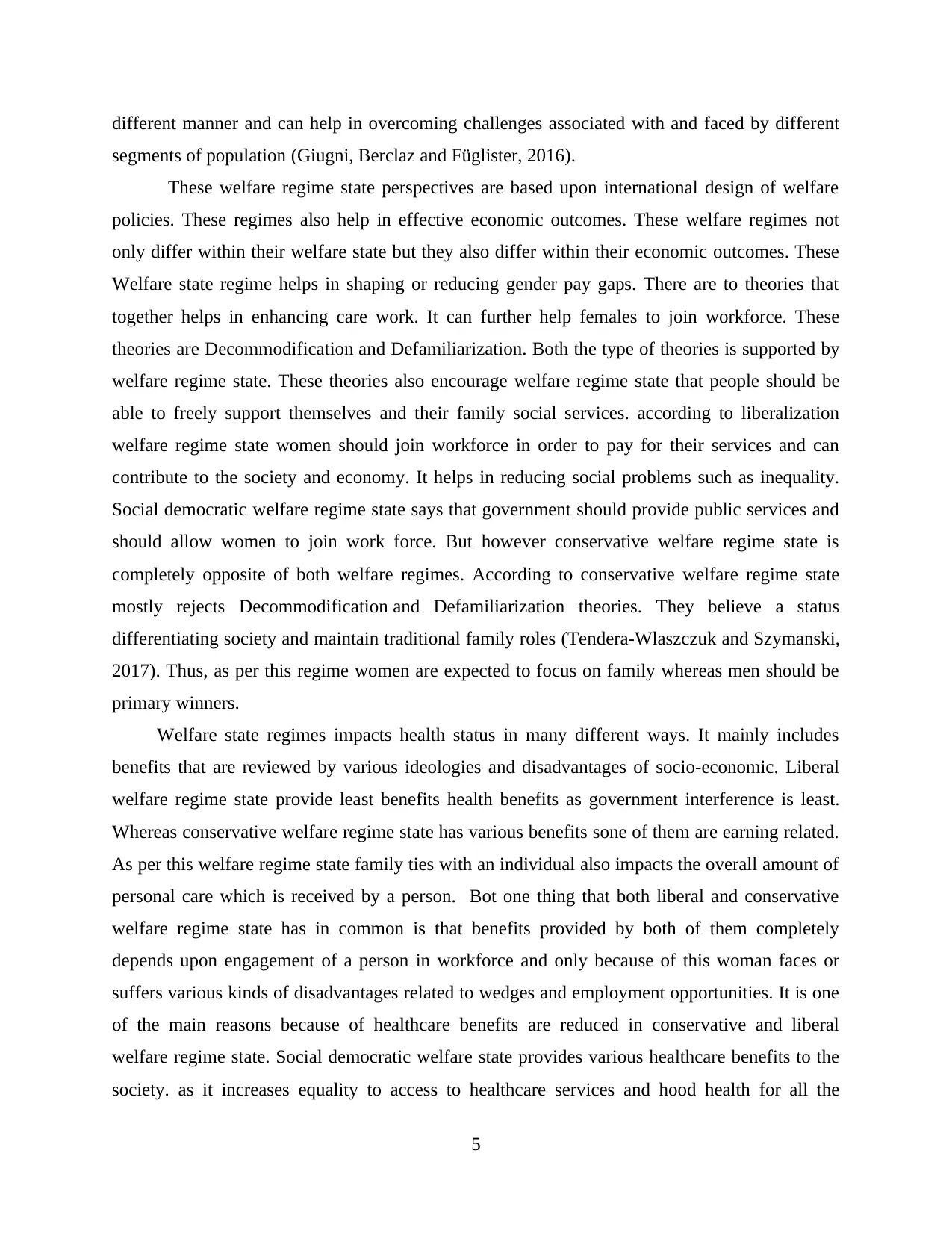
different manner and can help in overcoming challenges associated with and faced by different
segments of population (Giugni, Berclaz and Füglister, 2016).
These welfare regime state perspectives are based upon international design of welfare
policies. These regimes also help in effective economic outcomes. These welfare regimes not
only differ within their welfare state but they also differ within their economic outcomes. These
Welfare state regime helps in shaping or reducing gender pay gaps. There are to theories that
together helps in enhancing care work. It can further help females to join workforce. These
theories are Decommodification and Defamiliarization. Both the type of theories is supported by
welfare regime state. These theories also encourage welfare regime state that people should be
able to freely support themselves and their family social services. according to liberalization
welfare regime state women should join workforce in order to pay for their services and can
contribute to the society and economy. It helps in reducing social problems such as inequality.
Social democratic welfare regime state says that government should provide public services and
should allow women to join work force. But however conservative welfare regime state is
completely opposite of both welfare regimes. According to conservative welfare regime state
mostly rejects Decommodification and Defamiliarization theories. They believe a status
differentiating society and maintain traditional family roles (Tendera-Wlaszczuk and Szymanski,
2017). Thus, as per this regime women are expected to focus on family whereas men should be
primary winners.
Welfare state regimes impacts health status in many different ways. It mainly includes
benefits that are reviewed by various ideologies and disadvantages of socio-economic. Liberal
welfare regime state provide least benefits health benefits as government interference is least.
Whereas conservative welfare regime state has various benefits sone of them are earning related.
As per this welfare regime state family ties with an individual also impacts the overall amount of
personal care which is received by a person. Bot one thing that both liberal and conservative
welfare regime state has in common is that benefits provided by both of them completely
depends upon engagement of a person in workforce and only because of this woman faces or
suffers various kinds of disadvantages related to wedges and employment opportunities. It is one
of the main reasons because of healthcare benefits are reduced in conservative and liberal
welfare regime state. Social democratic welfare state provides various healthcare benefits to the
society. as it increases equality to access to healthcare services and hood health for all the
5
segments of population (Giugni, Berclaz and Füglister, 2016).
These welfare regime state perspectives are based upon international design of welfare
policies. These regimes also help in effective economic outcomes. These welfare regimes not
only differ within their welfare state but they also differ within their economic outcomes. These
Welfare state regime helps in shaping or reducing gender pay gaps. There are to theories that
together helps in enhancing care work. It can further help females to join workforce. These
theories are Decommodification and Defamiliarization. Both the type of theories is supported by
welfare regime state. These theories also encourage welfare regime state that people should be
able to freely support themselves and their family social services. according to liberalization
welfare regime state women should join workforce in order to pay for their services and can
contribute to the society and economy. It helps in reducing social problems such as inequality.
Social democratic welfare regime state says that government should provide public services and
should allow women to join work force. But however conservative welfare regime state is
completely opposite of both welfare regimes. According to conservative welfare regime state
mostly rejects Decommodification and Defamiliarization theories. They believe a status
differentiating society and maintain traditional family roles (Tendera-Wlaszczuk and Szymanski,
2017). Thus, as per this regime women are expected to focus on family whereas men should be
primary winners.
Welfare state regimes impacts health status in many different ways. It mainly includes
benefits that are reviewed by various ideologies and disadvantages of socio-economic. Liberal
welfare regime state provide least benefits health benefits as government interference is least.
Whereas conservative welfare regime state has various benefits sone of them are earning related.
As per this welfare regime state family ties with an individual also impacts the overall amount of
personal care which is received by a person. Bot one thing that both liberal and conservative
welfare regime state has in common is that benefits provided by both of them completely
depends upon engagement of a person in workforce and only because of this woman faces or
suffers various kinds of disadvantages related to wedges and employment opportunities. It is one
of the main reasons because of healthcare benefits are reduced in conservative and liberal
welfare regime state. Social democratic welfare state provides various healthcare benefits to the
society. as it increases equality to access to healthcare services and hood health for all the
5
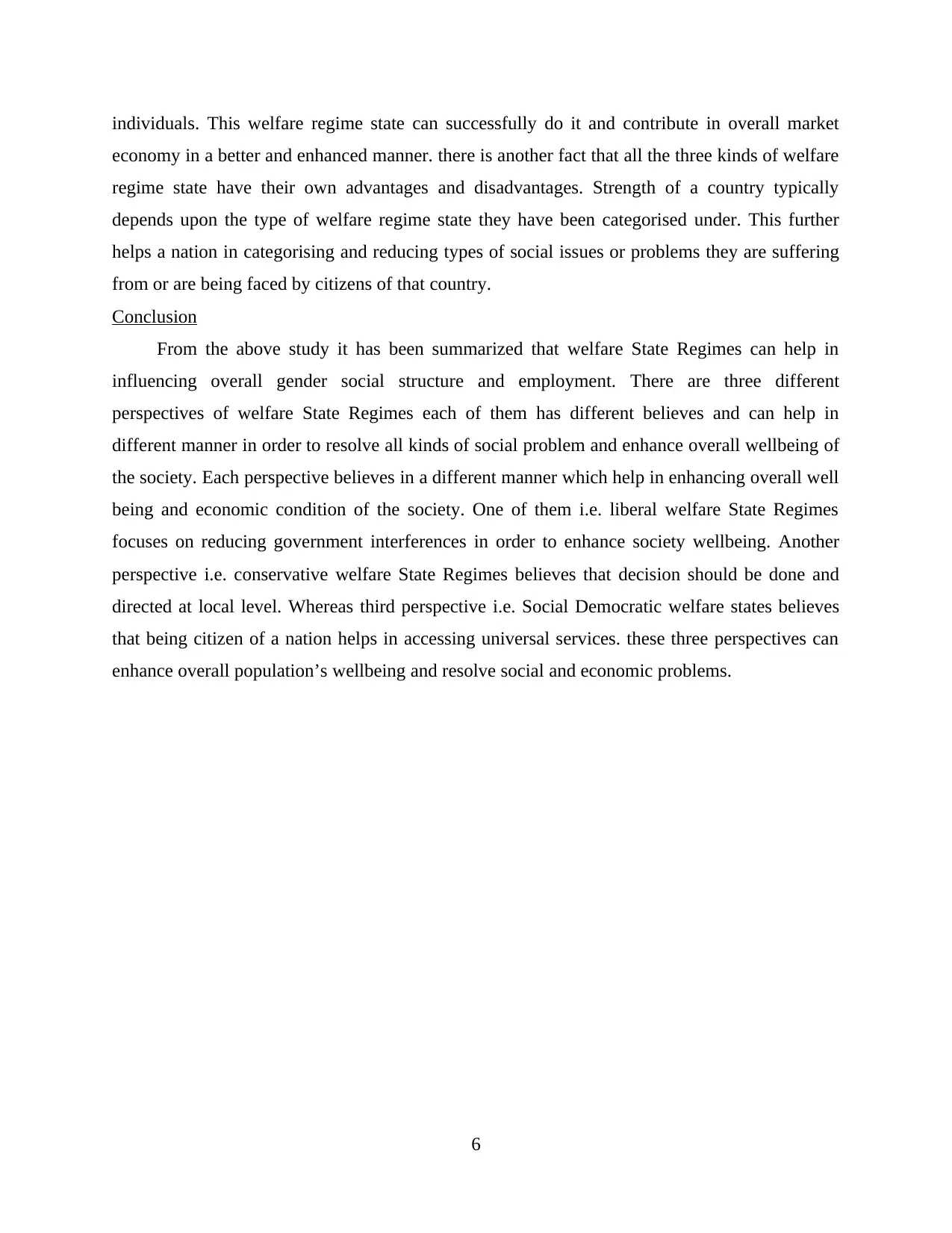
individuals. This welfare regime state can successfully do it and contribute in overall market
economy in a better and enhanced manner. there is another fact that all the three kinds of welfare
regime state have their own advantages and disadvantages. Strength of a country typically
depends upon the type of welfare regime state they have been categorised under. This further
helps a nation in categorising and reducing types of social issues or problems they are suffering
from or are being faced by citizens of that country.
Conclusion
From the above study it has been summarized that welfare State Regimes can help in
influencing overall gender social structure and employment. There are three different
perspectives of welfare State Regimes each of them has different believes and can help in
different manner in order to resolve all kinds of social problem and enhance overall wellbeing of
the society. Each perspective believes in a different manner which help in enhancing overall well
being and economic condition of the society. One of them i.e. liberal welfare State Regimes
focuses on reducing government interferences in order to enhance society wellbeing. Another
perspective i.e. conservative welfare State Regimes believes that decision should be done and
directed at local level. Whereas third perspective i.e. Social Democratic welfare states believes
that being citizen of a nation helps in accessing universal services. these three perspectives can
enhance overall population’s wellbeing and resolve social and economic problems.
6
economy in a better and enhanced manner. there is another fact that all the three kinds of welfare
regime state have their own advantages and disadvantages. Strength of a country typically
depends upon the type of welfare regime state they have been categorised under. This further
helps a nation in categorising and reducing types of social issues or problems they are suffering
from or are being faced by citizens of that country.
Conclusion
From the above study it has been summarized that welfare State Regimes can help in
influencing overall gender social structure and employment. There are three different
perspectives of welfare State Regimes each of them has different believes and can help in
different manner in order to resolve all kinds of social problem and enhance overall wellbeing of
the society. Each perspective believes in a different manner which help in enhancing overall well
being and economic condition of the society. One of them i.e. liberal welfare State Regimes
focuses on reducing government interferences in order to enhance society wellbeing. Another
perspective i.e. conservative welfare State Regimes believes that decision should be done and
directed at local level. Whereas third perspective i.e. Social Democratic welfare states believes
that being citizen of a nation helps in accessing universal services. these three perspectives can
enhance overall population’s wellbeing and resolve social and economic problems.
6
⊘ This is a preview!⊘
Do you want full access?
Subscribe today to unlock all pages.

Trusted by 1+ million students worldwide

7
Paraphrase This Document
Need a fresh take? Get an instant paraphrase of this document with our AI Paraphraser
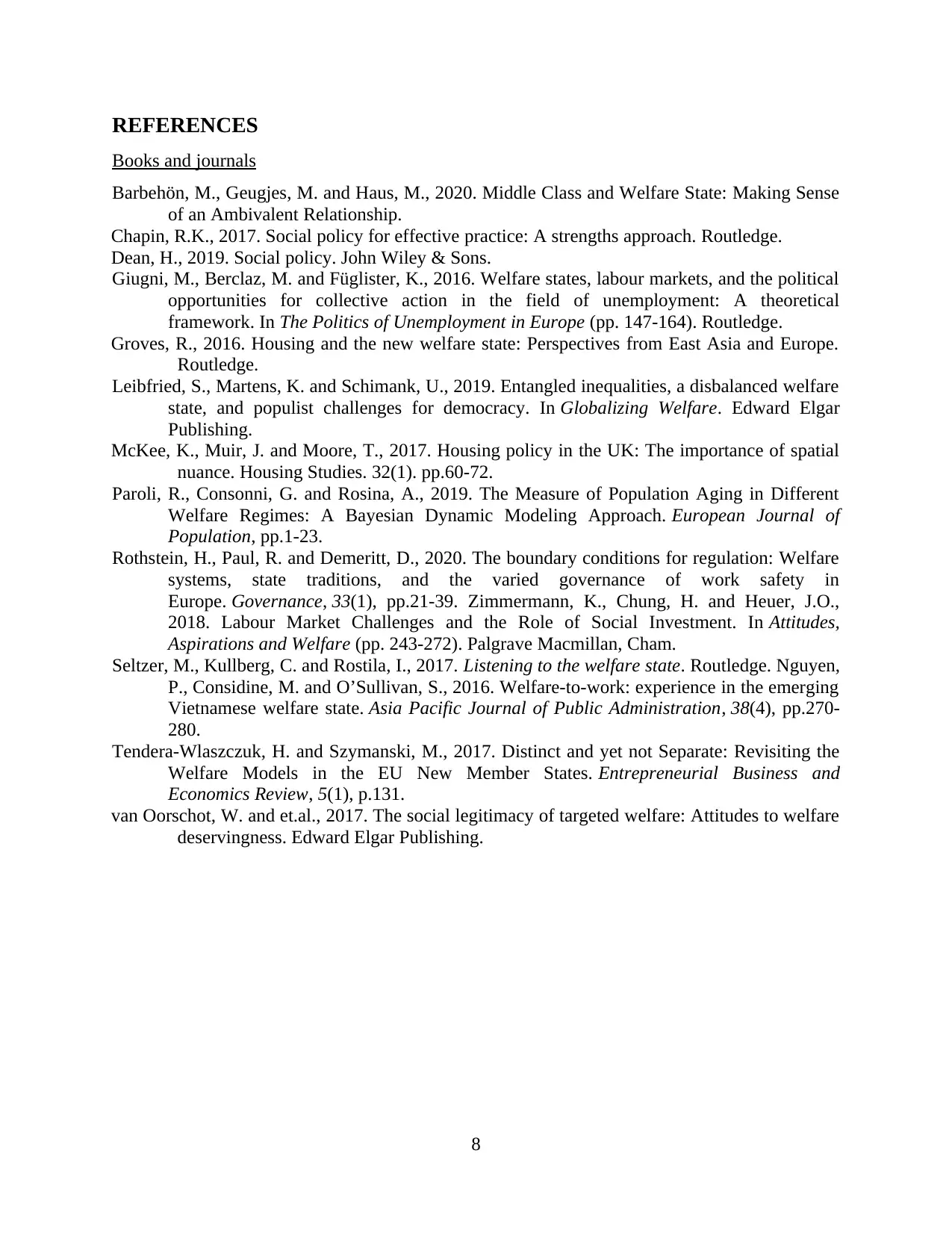
REFERENCES
Books and journals
Barbehön, M., Geugjes, M. and Haus, M., 2020. Middle Class and Welfare State: Making Sense
of an Ambivalent Relationship.
Chapin, R.K., 2017. Social policy for effective practice: A strengths approach. Routledge.
Dean, H., 2019. Social policy. John Wiley & Sons.
Giugni, M., Berclaz, M. and Füglister, K., 2016. Welfare states, labour markets, and the political
opportunities for collective action in the field of unemployment: A theoretical
framework. In The Politics of Unemployment in Europe (pp. 147-164). Routledge.
Groves, R., 2016. Housing and the new welfare state: Perspectives from East Asia and Europe.
Routledge.
Leibfried, S., Martens, K. and Schimank, U., 2019. Entangled inequalities, a disbalanced welfare
state, and populist challenges for democracy. In Globalizing Welfare. Edward Elgar
Publishing.
McKee, K., Muir, J. and Moore, T., 2017. Housing policy in the UK: The importance of spatial
nuance. Housing Studies. 32(1). pp.60-72.
Paroli, R., Consonni, G. and Rosina, A., 2019. The Measure of Population Aging in Different
Welfare Regimes: A Bayesian Dynamic Modeling Approach. European Journal of
Population, pp.1-23.
Rothstein, H., Paul, R. and Demeritt, D., 2020. The boundary conditions for regulation: Welfare
systems, state traditions, and the varied governance of work safety in
Europe. Governance, 33(1), pp.21-39. Zimmermann, K., Chung, H. and Heuer, J.O.,
2018. Labour Market Challenges and the Role of Social Investment. In Attitudes,
Aspirations and Welfare (pp. 243-272). Palgrave Macmillan, Cham.
Seltzer, M., Kullberg, C. and Rostila, I., 2017. Listening to the welfare state. Routledge. Nguyen,
P., Considine, M. and O’Sullivan, S., 2016. Welfare-to-work: experience in the emerging
Vietnamese welfare state. Asia Pacific Journal of Public Administration, 38(4), pp.270-
280.
Tendera-Wlaszczuk, H. and Szymanski, M., 2017. Distinct and yet not Separate: Revisiting the
Welfare Models in the EU New Member States. Entrepreneurial Business and
Economics Review, 5(1), p.131.
van Oorschot, W. and et.al., 2017. The social legitimacy of targeted welfare: Attitudes to welfare
deservingness. Edward Elgar Publishing.
8
Books and journals
Barbehön, M., Geugjes, M. and Haus, M., 2020. Middle Class and Welfare State: Making Sense
of an Ambivalent Relationship.
Chapin, R.K., 2017. Social policy for effective practice: A strengths approach. Routledge.
Dean, H., 2019. Social policy. John Wiley & Sons.
Giugni, M., Berclaz, M. and Füglister, K., 2016. Welfare states, labour markets, and the political
opportunities for collective action in the field of unemployment: A theoretical
framework. In The Politics of Unemployment in Europe (pp. 147-164). Routledge.
Groves, R., 2016. Housing and the new welfare state: Perspectives from East Asia and Europe.
Routledge.
Leibfried, S., Martens, K. and Schimank, U., 2019. Entangled inequalities, a disbalanced welfare
state, and populist challenges for democracy. In Globalizing Welfare. Edward Elgar
Publishing.
McKee, K., Muir, J. and Moore, T., 2017. Housing policy in the UK: The importance of spatial
nuance. Housing Studies. 32(1). pp.60-72.
Paroli, R., Consonni, G. and Rosina, A., 2019. The Measure of Population Aging in Different
Welfare Regimes: A Bayesian Dynamic Modeling Approach. European Journal of
Population, pp.1-23.
Rothstein, H., Paul, R. and Demeritt, D., 2020. The boundary conditions for regulation: Welfare
systems, state traditions, and the varied governance of work safety in
Europe. Governance, 33(1), pp.21-39. Zimmermann, K., Chung, H. and Heuer, J.O.,
2018. Labour Market Challenges and the Role of Social Investment. In Attitudes,
Aspirations and Welfare (pp. 243-272). Palgrave Macmillan, Cham.
Seltzer, M., Kullberg, C. and Rostila, I., 2017. Listening to the welfare state. Routledge. Nguyen,
P., Considine, M. and O’Sullivan, S., 2016. Welfare-to-work: experience in the emerging
Vietnamese welfare state. Asia Pacific Journal of Public Administration, 38(4), pp.270-
280.
Tendera-Wlaszczuk, H. and Szymanski, M., 2017. Distinct and yet not Separate: Revisiting the
Welfare Models in the EU New Member States. Entrepreneurial Business and
Economics Review, 5(1), p.131.
van Oorschot, W. and et.al., 2017. The social legitimacy of targeted welfare: Attitudes to welfare
deservingness. Edward Elgar Publishing.
8
1 out of 8
Related Documents
Your All-in-One AI-Powered Toolkit for Academic Success.
+13062052269
info@desklib.com
Available 24*7 on WhatsApp / Email
![[object Object]](/_next/static/media/star-bottom.7253800d.svg)
Unlock your academic potential
Copyright © 2020–2025 A2Z Services. All Rights Reserved. Developed and managed by ZUCOL.





